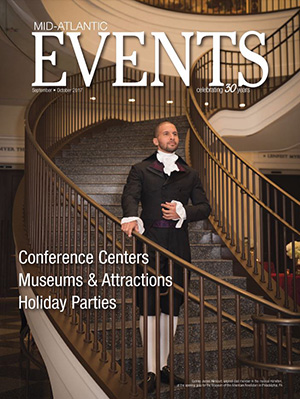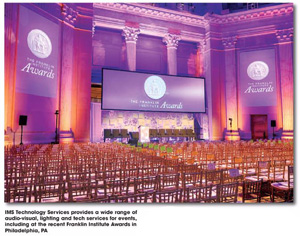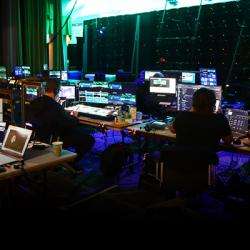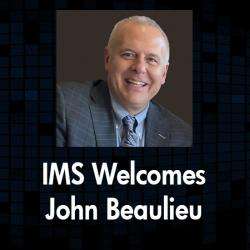IMS in September-October 2017 Issue of Mid-Atlantic Events Magazine
 Jason Cataldi, CTS was interviewed for the “Technology Update” article that appears in the September/October 2017 edition of Mid-Atlantic Events Magazine.
Jason Cataldi, CTS was interviewed for the “Technology Update” article that appears in the September/October 2017 edition of Mid-Atlantic Events Magazine.
Jason Cataldi, VP of sales and marketing for IMS Technology Services, Inc., says that technology isn't the only field that is influenced by rapid development and near continuous transformation. He observes that the meeting and event landscape is ever evolving, adapting, changing in the current business climate as well, and there is an ever increasing need to communicate one's message clearly in a way that will resonate with an audience.
"The technology we utilize can enhance the message or conversely distract from what was the best of intentions," cautions Cataldi. "A recent study suggests that only 20 percent of what was learned at a conference is retained. In fact, a person is only actively listening for about 20 minutes of sustained time. If these studies tell us anything, it is that we need to captivate our audience - or as some would say - entertain them."
"Our goal is the manage the emotions of the event," he adds. "From the initial concept to measuring 'calls to action' post-event, a consistent focus on attendee engagement and creating an immersive experiential environment are our key indicators for determining success."
Cataldi says that of the technologies IMS' clients utilize at most of their meetings, many involve social and virtual interaction, gamification, live tracking/real time analytics, and mobile-friendly responsive meeting materials.
"IMS recently hosted Event Trends 2017 at Lincoln Financial Field (in Philadelphia, PA)," Cataldi explains. "Many of the aforementioned technologies and strategies were demonstrated throughout the day. Take, for instance, digital signage. Not so long ago, we would be placing easels throughout the event space in high traffic areas in hopes that our guests would see them. Now, we have the ability to create 'heads up' messaging and advertising - real time alerts for flight delays, traffic, weather conditions, enhancement of brand recognition, attracting attention to key sessions with infographics, and, through the use of hashtags, developing a social interaction channel."
He notes that this specific technology aids the attendee and helps to keep them informed while also driving valuable sponsorship and advertising dollars. "Our clients have recognized that the positive returns are far greater than the initial investment."
 Sometimes the choice of venue can have an impact on the technology options available for producing a meeting or event. Cataldi notes that often overlooked features of a venue like ceiling height, soffits and seating capacity change how technology needs to be set up. For example, whether ground supporting or rigging is needed for audio, video, lighting or scenic decor.
Sometimes the choice of venue can have an impact on the technology options available for producing a meeting or event. Cataldi notes that often overlooked features of a venue like ceiling height, soffits and seating capacity change how technology needs to be set up. For example, whether ground supporting or rigging is needed for audio, video, lighting or scenic decor.
"Our team of production managers and creative design engineers work closely with planners to determine the best room orientation that will support their stakeholders' message. Having the ability to show a planner 3D and cinema motion renderings from the perspective of the last row, three seats from the aisle as well as from the point-of-view of a presenter really allows our clients to make the best decisions," he explains.
To design a meeting environment with a "wow factor," Cataldi suggests that everything from video mapping with custom content messaging, true surround sound, the latest in lighting design, and understanding the challenges of the space all play heavily into what the planner can and cannot do.
"Drafting a visual plan will aid you with the information needed to anticipate venue charges for rigging points, power requirements, and liaison fees," he adds. Given the importance of the Internet and how much everyone relies on it these days, IMS recommends establishing bandwidth needs along with the associated fee structures in the very early phases of the planning process. For those whose vision includes the use of social media or event apps, this will need to be taken into consideration too, so as to avoid potential connectivity issues among guests during the event. It is important, too, to be observant of the physical space when performing site visits. "Steel and concrete spaces traditionally will impede connectivity and leave you with spotty coverage and responsiveness," says Cataldi.
When it comes to real time feedback, he advises that clients seek both direct and indirect interaction with attendees. For this reason, planning ahead for professional and social dialogue is really important.
"Instead of a traditional Q&A panel discussion, maybe try a Think Tank-style meeting," suggest Cataldi. "Ask for questions pre-event, and then seat your audience in pods or small groups while a keynote moderator drives the conversation."
IMS recently held a Think Tank with over 100 meeting professionals, and Jim Cohn, publisher/editor of Mid-Atlantic Events Magazine served as the moderator. "Questions were submitted via our event app and by qualified guests for additional points in our gamification challenge. As each question was presented, the groups dove into open dialogue, shared ideas and experiences and ultimately conveyed their thoughts to the entire room," explains Cataldi.
Another way to create this type of information sharing is through non-traditional team building. "At Event Trends 2017, the special events department of the Philadelphia Eagles partnered with Aramark to come up with a team building challenge," he continues. "Groups were asked questions and presented with challenges. With each correct answer or completed task, they earned the ability to win ingredients to create a one-of-a-kind salsa that was prepared by the chef, placed into a competition at the end of the event, and served during the networking hour! This unconventional session provided an opportunity for guests to meet, laugh, and learn from each other while also creating a little healthy competition."
Read the full article in the current issue of Mid-Atlantic Events Magazine.
Share This Article
Categories
Latest Posts

Philadelphia 2026: Is Your Venue Ready for the Spotlight?

Scalable AV Infrastructure for Life Science Enterprises

Extend Your Reach: The Power of Virtual and Hybrid Events

Why Every Detail Matters in Investor and Year-End Meetings

IMS Technology Services Welcomes John Beaulieu
Tags
Contact Us
- Headquarters: 3055 MCCANN FARM DRIVE, GARNET VALLEY, PA 19060
- Event Staging: 2000 COLUMBIA AVENUE, SUITE 300, LINWOOD, PA 19061
- Southeast Office: 404 SUNPORT LANE, SUITE 350, ORLANDO, FL 32809
- Phone: + 610-361-1870
- Contact Us
Services
Recent Posts

Philadelphia 2026: Is Your Venue Ready for the Spotlight?

